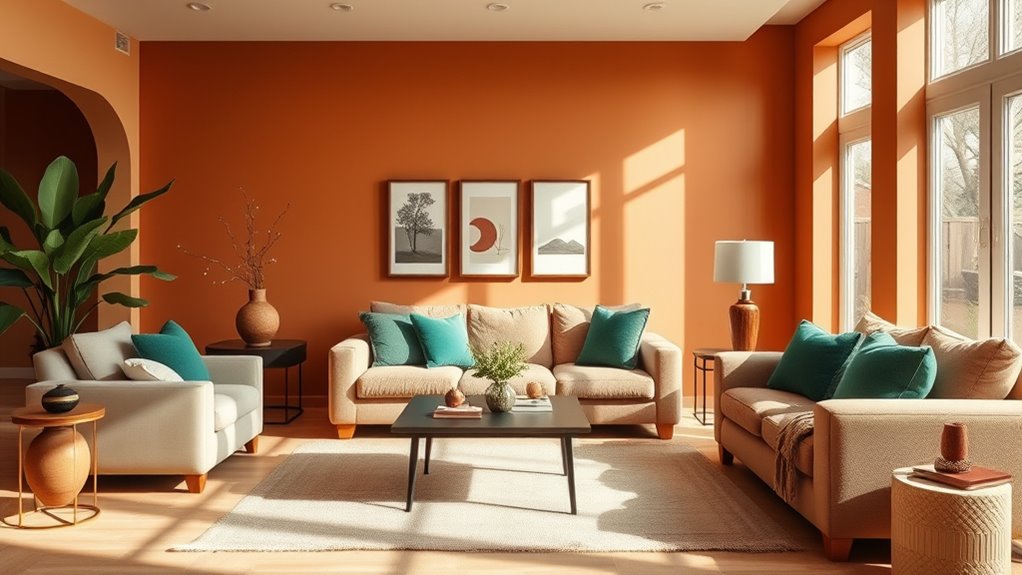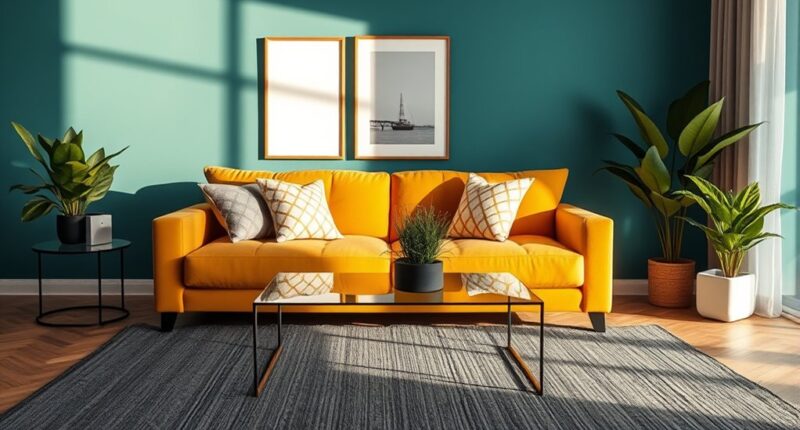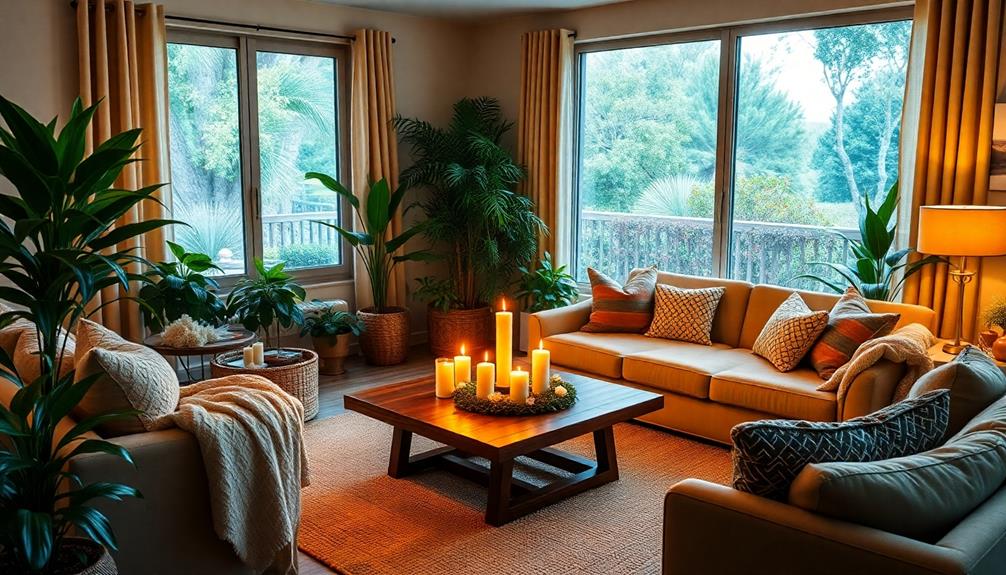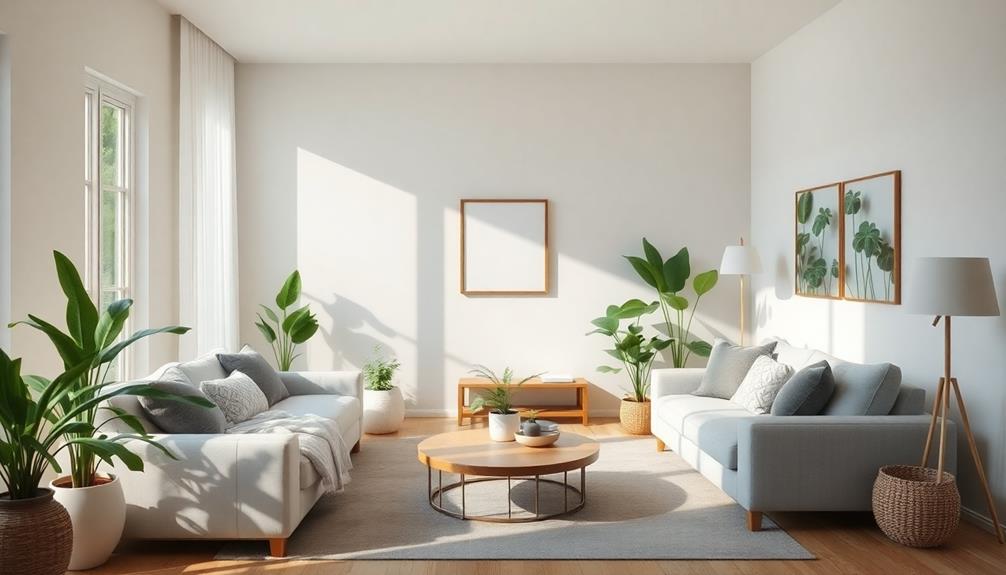Your living room color choices reveal your personality, mood, and emotional needs. Soft blues suggest you value calmness and serenity, while vibrant reds signal energy and urgency. Neutral tones reflect simplicity, and bright colors show vibrancy and enthusiasm. Your selections are influenced by subconscious preferences and cultural background, shaping how you feel in your space. Understanding these subtle signals can help you craft a space that truly reflects who you are—continue to explore what your palette says about you.
Key Takeaways
- Your living-room colors reveal personality traits, such as calmness with blues or vibrancy with yellows and oranges.
- Neutral tones indicate a preference for simplicity, calmness, or professionalism in your personal space.
- Bold, dark hues suggest sophistication, introspection, or a desire for richness and depth.
- Color choices reflect emotional needs, aspirations, and subconscious influences shaping your environment.
- The use of contrast and visual clarity enhances emotional impact, making your space feel more authentic and intentional.

Colors influence our thoughts, feelings, and behaviors more than we often realize. When you walk into a room, the colors surrounding you can subtly shape your mood and even your perceptions without you noticing. This is because of the way color perception interacts with your emotional impact. For example, a soft blue can evoke calmness and serenity, while a vibrant red might energize you or provoke a sense of urgency. Your choices for a living room palette aren’t just about aesthetics—they reflect your personality and influence how you feel in that space. Understanding the psychology behind these choices can help you make more intentional decisions that align with your desired atmosphere.
The emotional impact of color is powerful. When selecting your living room colors, you might be drawn to certain hues because they resonate with your inner state or aspirations. If you prefer neutral shades like beige or gray, it suggests you value simplicity, calmness, and a versatile backdrop that can adapt to changing tastes or moods. Bright, bold colors like yellow or orange may reveal your energetic personality and desire for vibrancy, while darker hues such as navy or charcoal can indicate a preference for sophistication or introspection. Your color perception is also influenced by personal experiences and cultural background, which shape how you interpret specific colors’ emotional significance. Additionally, understanding the role of contrast ratio can help you select colors that enhance visual clarity and emotional impact within your space.
Your subconscious often guides your color choices, even if you aren’t fully aware of it. The colors you gravitate toward reveal your inner world—your mood, personality, and even your aspirations. For instance, choosing a lush green palette might suggest a connection to nature and a desire for balance. Alternatively, opting for deep reds or purples might point to a love of richness and a desire to convey power or creativity. These choices aren’t random; they’re a reflection of your emotional state and how you want others to perceive you. When you select colors for your living room, you’re not just decorating; you’re communicating a message—whether it’s warmth, professionalism, relaxation, or excitement.
Ultimately, understanding the psychology behind color choices empowers you to create spaces that genuinely represent who you are and how you want to feel. By paying attention to your emotional responses to different hues, you can craft a living room environment that nurtures your well-being and aligns with your personal style. Think of your palette as a language—each color conveying a subtle message about your identity and mood. When you make conscious choices about color perception and emotional impact, you’re not only enhancing your space but also shaping your daily experience in ways that support your emotional health and self-expression.
Frequently Asked Questions
Can Color Choices Influence Mood Over the Long Term?
Color choices can definitely influence your mood over the long term by shaping emotional responses through color symbolism. Bright, warm hues like yellow or orange may boost your energy and positivity, while cooler tones like blue or green promote calmness and relaxation. Consistently surrounding yourself with specific colors can reinforce these feelings, creating a lasting impact on your emotional well-being and overall outlook.
Do Cultural Backgrounds Affect Color Perception and Preferences?
Did you know that cultural symbolism influences 80% of color preferences worldwide? Your cultural background shapes how you perceive colors and what they represent. Regional color preferences are deeply rooted in history and tradition, affecting your choices and reactions. So, whether you favor bold reds or calming blues, your cultural background plays a vital role in how you interpret and connect with different colors.
How Do Personal Experiences Shape Color Associations?
Your personal experiences heavily influence your color associations through color memory and emotional resonance. When you encounter certain colors, they trigger memories or feelings linked to past events or experiences. For example, a specific shade might remind you of a joyful summer or a calming moment, shaping your preferences and perceptions. These emotional connections make your color choices unique, reflecting your individual history and the feelings you associate with different hues.
Are There Specific Colors Linked to Productivity in a Living Room?
Did you know that blue is linked to increased productivity? In color psychology, blue symbolizes calmness and focus, making it ideal for a productive living room. Cooler shades like green also promote relaxation and concentration. Choosing colors with strong color symbolism can positively influence your mood and efficiency, helping you stay energized and focused in your space. So, pick hues that align with your productivity goals for a more functional living room.
Can Color Therapy Be Effective in Home Design?
Color therapy can be quite effective in home design because it taps into color psychology and its emotional impact. You can choose colors that boost your mood, reduce stress, or energize your space. By intentionally selecting hues based on their psychological effects, you create a home environment that supports your emotional well-being. So, yes, incorporating color therapy into your design can make your living space more harmonious and personalized.
Conclusion
Your living room palette reveals more about you than you might realize—colors influence mood and even decision-making. Did you know that 84% of people say color directly impacts how they feel in a space? So next time you’re choosing a shade, remember it’s not just about style but also about expressing your personality and shaping your daily experiences. Your color choices can truly transform your environment and your mindset.









